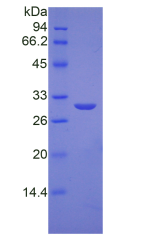Active Ornithine Decarboxylase (ODC)
ODC1
- Product No.APB332Hu01
- Organism SpeciesHomo sapiens (Human) Same name, Different species.
- Buffer Formulation20mM Tris, 150mM NaCl, pH8.0, containing 1mM EDTA, 1mM DTT, 0.01% SKL, 5% Trehalose and Proclin300.
- Traits Freeze-dried powder
- Purity> 90%
- Isoelectric Point6.3
- ApplicationsCell culture; Activity Assays.
- DownloadInstruction Manual
- UOM 10µg50µg 200µg 1mg 5mg
- FOB
US$ 310
US$ 774
US$ 1548
US$ 4644
US$ 11610
For more details, please contact local distributors!
ACTIVITY TEST

Figure. The binding activity of ODC with TK1.
Ornithine decarboxylase (ODC) is an enzyme can catalyze the decarboxylation of ornithine (a product of the urea cycle) to form putrescine. The ornithine decarboxylation reaction catalyzed by ornithine decarboxylase is the first and committed step in the synthesis of polyamines, particularly putrescine, spermidine and spermine. Polyamines are important for stabilizing DNA structure, the DNA double strand-break repair pathway and as antioxidants. Therefore, ornithine decarboxylase is an essential enzyme for cell growth, producing the polyamines necessary to stabilize newly synthesized DNA. Lack of ODC causes cell apoptosis in embryonic mice, induced by DNA damage. Besides, Thymidine Kinase 1, Soluble (TK1) has been identified as an interactor of ODC, thus a binding ELISA assay was conducted to detect the interaction of recombinant human ODC and recombinant human TK1. Briefly, ODC were diluted serially in PBS with 0.01% BSA (pH 7.4). Duplicate samples of 100μL were then transferred to TK1-coated microtiter wells and incubated for 2h at 37℃. Wells were washed with PBST and incubated for 1h with anti-ODC pAb, then aspirated and washed 3 times. After incubation with HRP labelled secondary antibody, wells were aspirated and washed 3 times. With the addition of substrate solution, wells were incubated 15-25 minutes at 37℃. Finally, add 50µL stop solution to the wells and read at 450nm immediately. The binding activity of ODC and TK1 was shown in Figure 1, and this effect was in a dose dependent manner.
USAGE
Reconstitute in 20mM Tris, 150mM NaCl (pH8.0) to a concentration of 0.1-1.0 mg/mL. Do not vortex.
STORAGE
Avoid repeated freeze/thaw cycles. Store at 2-8°C for one month. Aliquot and store at -80°C for 12 months.
STABILITY
The thermal stability is described by the loss rate. The loss rate was determined by accelerated thermal degradation test, that is, incubate the protein at 37°C for 48h, and no obvious degradation and precipitation were observed. The loss rate is less than 5% within the expiration date under appropriate storage condition.
GIVEAWAYS
INCREMENT SERVICES
-
 BCA Protein Quantification Kit
BCA Protein Quantification Kit
-
 Molecular Mass Marker for Protein
Molecular Mass Marker for Protein
-
 Monoclonal Antibody Customized Service
Monoclonal Antibody Customized Service
-
 Polyclonal Antibody Customized Service
Polyclonal Antibody Customized Service
-
 Protein Activity Test Experiment Service
Protein Activity Test Experiment Service
-
 Electrophoretic Mobility Shift Assay (EMSA) Experiment Service
Electrophoretic Mobility Shift Assay (EMSA) Experiment Service
-
 Buffer
Buffer
-
 Lentivirus Packaging Experiment Service
Lentivirus Packaging Experiment Service
-
 Adenovirus Packaging Experiment Service
Adenovirus Packaging Experiment Service
-
 Real Time PCR Experimental Service
Real Time PCR Experimental Service
-
 Spike RBD Protein (S-RBD)
Spike RBD Protein (S-RBD)
-
 Protein G
Protein G
-
 Protein A
Protein A
| Magazine | Citations |
| Biomedicine & Pharmacotherapy | Insights on ornithine decarboxylase silencing as a potential strategy for targeting retinoblastoma pubmed:29241071 |
| Catalog No. | Related products for research use of Homo sapiens (Human) Organism species | Applications (RESEARCH USE ONLY!) |
| RPB332Hu01 | Recombinant Ornithine Decarboxylase (ODC) | Positive Control; Immunogen; SDS-PAGE; WB. |
| APB332Hu01 | Active Ornithine Decarboxylase (ODC) | Cell culture; Activity Assays. |
| APB332Hu02 | Active Ornithine Decarboxylase (ODC) | Cell culture; Activity Assays. |
| RPB332Hu03 | Recombinant Ornithine Decarboxylase (ODC) | Positive Control; Immunogen; SDS-PAGE; WB. |
| RPB332Hu02 | Recombinant Ornithine Decarboxylase (ODC) | Positive Control; Immunogen; SDS-PAGE; WB. |
| PAB332Hu01 | Polyclonal Antibody to Ornithine Decarboxylase (ODC) | WB; IHC; ICC; IP. |
| PAB332Hu02 | Polyclonal Antibody to Ornithine Decarboxylase (ODC) | WB; IHC; ICC; IP. |
| LAB332Hu71 | Biotin-Linked Polyclonal Antibody to Ornithine Decarboxylase (ODC) | WB; IHC; ICC. |
| MAB332Hu22 | Monoclonal Antibody to Ornithine Decarboxylase (ODC) | WB; IHC; ICC; IP. |
| SEB332Hu | ELISA Kit for Ornithine Decarboxylase (ODC) | Enzyme-linked immunosorbent assay for Antigen Detection. |
| LMB332Hu | Multiplex Assay Kit for Ornithine Decarboxylase (ODC) ,etc. by FLIA (Flow Luminescence Immunoassay) | FLIA Kit for Antigen Detection. |









